Laura Youngson Coll's nature-inspired sculptures go on show in London as part of the 2014 Perrier-Jouët Arts Salon Prize
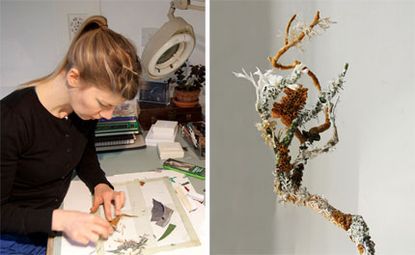
British sculptor Laura Youngson Coll, pictured here in her studio, has been awarded this year's Perrier-Jouët Arts Salon Prize for her intricate artworks inspired by natural forms and organic structures
Leather flowers and lichen are growing within London's Contemporary Applied Arts. Their strangely beautiful and delicate forms, which give new life to discarded scraps from bookbinding, are the handiwork of British sculptor Laura Youngson Coll, winner of this year's Perrier-Jouët Arts Salon Prize.
Youngson Coll was selected from 10 candidates for the prize, which celebrates contemporary craftsmanship and stems from the house's long history of patronage of the arts. The sculptor was chosen by the Salon - a gathering of leading creative lights who meet to share ideas and debate developments in the arts - for the way her work reflects the ethos of Perrier-Jouët and its Art Nouveau heritage, with pieces inspired by natural forms and organic structures.
The sculptor has won £10,000 in cash to support her development and a solo show (her first) at Contemporary Applied Arts, which opens tomorrow. Alongside some earlier works that feature flowers and a three-dimensional interpretation of Ernst Haeckel's 19th century studies of cell forms, there is the personal research that the artist has been carrying out for several years, studying lichens and moss.
'I have been observing lichens for a while,' she explains. 'I have always liked their details, these microcosms of environments often overlooked. A few years ago I was traveling quite extensively, and it's interesting, looking at the minutiae of any environment, how you can find similarities even on the other side of the world.'
This fascination with nature and the impact of human intervention inspired her 'Indicator Species' series, a study of five environments and the lichens that grow in each, ranging from reindeer moss in the Arctic that was exposed to Chernobyl nuclear contamination, to the lichens found in urban areas of London.
'These things are adapting because we have polluted or we have done something to the environment, and maybe we should take more notice,' she adds. While they might be laced with commentary on our treatment of nature, her rendition of the lichens, perched on small sticks, has a fairytale-like quality, responding to the Art Nouveau motto, to 'transform the mundane of everyday life into something truly beautiful'.
The series is carefully assembled from leather and vellum. 'I am very much guided by the material,' the artist says, 'and my work is always being transformed in the making process - you have happy accidents and you discover a lot while you are making.'
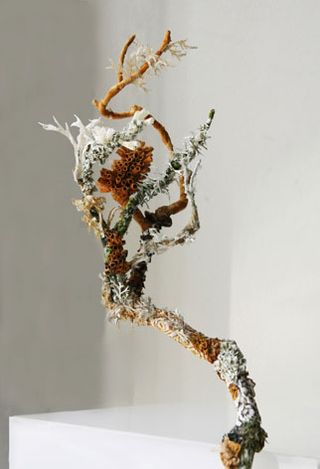
'Untitled (Lichen)', 2013. The artist's work is based personal research that she has been carrying out for several years, studying lichens and moss
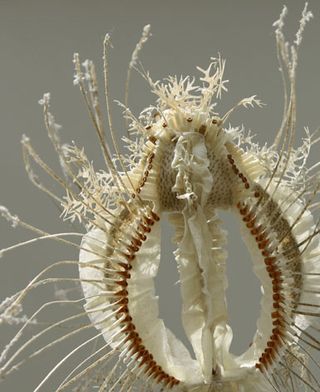
Some of Youngson Coll's works feature a three-dimensional interpretation of Ernst Haeckel's 19th century studies of cell forms. Pictured is a detail of 'Haeckel 1', 2014, comprising vellum, supernatural vellum and veg-tan leather detailing
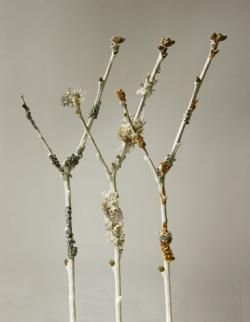
The sculptor's fascination with nature and the impact of human intervention inspired her 'Indicator Species' series, a study of five environments and the lichens that grow in each, ranging from reindeer moss exposed to radiation in the Arctic to the lichens found in urban areas of London. From left: 'Eutrophication', 'Radionuclides', 'London', 2014
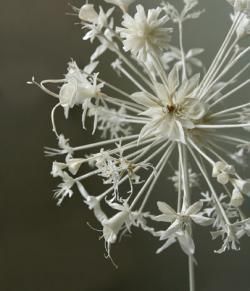
Detail of 'White Garden', 2013, which features a spectacular flower head inspired by the Gertrude Jekyll-influenced White Garden at Barrington Court in Somerset
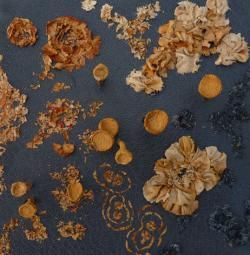
Youngson Coll experiments with different lichen forms using veg-tan goatskin leather

The sculptor plays with different sheep hair leathers to reveal follicle patterns in the material
ADDRESS
Contemporary Applied Arts
89 Southwark Street
London SE1 0HX
Wallpaper* Newsletter
Receive our daily digest of inspiration, escapism and design stories from around the world direct to your inbox
Rosa Bertoli was born in Udine, Italy, and now lives in London. Since 2014, she has been the Design Editor of Wallpaper*, where she oversees design content for the print and online editions, as well as special editorial projects. Through her role at Wallpaper*, she has written extensively about all areas of design. Rosa has been speaker and moderator for various design talks and conferences including London Craft Week, Maison & Objet, The Italian Cultural Institute (London), Clippings, Zaha Hadid Design, Kartell and Frieze Art Fair. Rosa has been on judging panels for the Chart Architecture Award, the Dutch Design Awards and the DesignGuild Marks. She has written for numerous English and Italian language publications, and worked as a content and communication consultant for fashion and design brands.
-
 Pininfarina Battista Reversario is a new one-off electric hypercar
Pininfarina Battista Reversario is a new one-off electric hypercarThe all-electric Pininfarina Battista Reversario is joining its aesthetic inverse in an ultra-select car collector’s garage. We take a look at a car built to a very precise order
By Jonathan Bell Published
-
 Fernando Jorge’s fluid diamond earrings show his curve appeal
Fernando Jorge’s fluid diamond earrings show his curve appealDiscover Brazilian jewellery designer Fernando Jorge's snake-like silhouettes and graphic shapes
By Hannah Silver Published
-
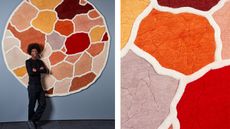 Abreham Brioschi debuts Ethiopia-inspired rugs for Nodus
Abreham Brioschi debuts Ethiopia-inspired rugs for NodusAbreham Brioschi teams up with luxury rug experts Nodus to translate visions from his heritage into a tactile reality
By Ifeoluwa Adedeji Published
-
 Peter Blake’s sculptures spark joy at Waddington Custot in London
Peter Blake’s sculptures spark joy at Waddington Custot in London‘Peter Blake: Sculpture and Other Matters’, at London's Waddington Custot, spans six decades of the artist's career
By Hannah Silver Published
-
 Oozing, squidgy, erupting forms come alive at Hayward Gallery
Oozing, squidgy, erupting forms come alive at Hayward Gallery‘When Forms Come Alive: Sixty Years of Restless Sculpture’ at Hayward Gallery, London, is a group show full of twists and turns
By Hannah Silver Published
-
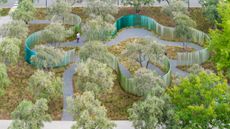 New glass sculpture creates a verdant wonderland at Apple’s Cupertino HQ
New glass sculpture creates a verdant wonderland at Apple’s Cupertino HQ‘Mirage’ at Apple Park is the work of Zeller & Moye and artist Katie Paterson, a shimmering array of glass columns that snakes through the grounds of the company’s monumental HQ
By Jonathan Bell Published
-
 Man Ray’s sculptures go on show in New York
Man Ray’s sculptures go on show in New York‘Man Ray: Other Objects’ opens at Luxembourg + Co, New York, revealing their author’s ‘artistic revolution’
By Hannah Silver Published
-
 The best London art exhibitions to see now
The best London art exhibitions to see nowYour guide to the best London art exhibitions, as chosen by the Wallpaper* arts desk
By Hannah Silver Published
-
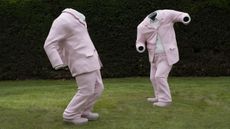 Erwin Wurm’s pop-coloured fantasy land at Yorkshire Sculpture Park
Erwin Wurm’s pop-coloured fantasy land at Yorkshire Sculpture ParkIn Erwin Wurm’s first UK museum show, ‘Trap of the Truth’, the artist transforms Yorkshire Sculpture Park into a slightly warped wonderland (10 June 2023 – 28 April 2024)
By Harriet Lloyd-Smith Published
-
 Sculptor Arnaldo Pomodoro transforms Fendi’s Rome HQ into a theatre of myth and magic
Sculptor Arnaldo Pomodoro transforms Fendi’s Rome HQ into a theatre of myth and magicFendi’s Roman HQ sets the scene for ‘Il Grande Teatro delle Civiltà’ a major show by Italian sculptor Arnaldo Pomodoro, who has also created a one-off edition of the house’s iconic Peekaboo bag. Read more in the July 2023 Issue of Wallpaper*, on newsstands 8 June
By Harriet Lloyd-Smith Published
-
 Superflex on building an underwater city for fish: ‘there are different rules down there’
Superflex on building an underwater city for fish: ‘there are different rules down there’Danish art collective Superflex discuss their ambitious Super Reef, an underwater urbanisation project aiming to restore more than 55 square kilometres of stone reef in Danish seas
By Alice Godwin Published